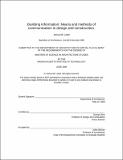| dc.contributor.advisor | George Stiny. | en_US |
| dc.contributor.author | Lobel, Joshua M | en_US |
| dc.contributor.other | Massachusetts Institute of Technology. Dept. of Architecture. | en_US |
| dc.date.accessioned | 2008-12-11T16:57:12Z | |
| dc.date.available | 2008-12-11T16:57:12Z | |
| dc.date.copyright | 2008 | en_US |
| dc.date.issued | 2008 | en_US |
| dc.identifier.uri | http://hdl.handle.net/1721.1/43747 | |
| dc.description | Thesis (S.M.)--Massachusetts Institute of Technology, Dept. of Architecture, 2008. | en_US |
| dc.description | This electronic version was submitted by the student author. The certified thesis is available in the Institute Archives and Special Collections. | en_US |
| dc.description | Includes bibliographical references (p. 73-77). | en_US |
| dc.description.abstract | Architects are trained and practiced in the means and methods of design. These are distinct from the physical means and methods of construction, which have traditionally been in the hands of contractors. The successful realization of construction does not necessitate or rely on a direct link between the processes of design and construction. However, the constructibility of a design is dependent on an effective means of communicating between the two. This thesis illustrates that the perceived complexity of constructibility is often predicated on the efficacy of communication between the designer and the contractor. I present three models of communication: a linear transmissive model similar to that of Shannon and Weaver, a "speech-circuit" model based on that of Saussure, and a semiotic-constructionist model derived from Peirce and Papert. Through interviews, observations, and experiments with practicing architects and architecture students, I investigate the implications of these models on the perceived and contractual roles and responsibilities of architects and contractors. My findings suggest that in design, communication is also an act of design and construction. Best illustrated by the constructionist model of communication, acts of making and re-making are fundamental to the way that architects and contractors relate to design information. The automation of these acts through emerging technologies - such as BIM - lead to increased reliance on fixed data constructs in lieu of dynamic, individual interpretations of information. This can result in the loss of expert knowledge which does not fit a standardized model, and the dis-integration of meaningful communication between design and construction information. | en_US |
| dc.description.statementofresponsibility | Joshua M. Lobel. | en_US |
| dc.format.extent | 98 p. | en_US |
| dc.language.iso | eng | en_US |
| dc.publisher | Massachusetts Institute of Technology | en_US |
| dc.rights | M.I.T. theses are protected by
copyright. They may be viewed from this source for any purpose, but
reproduction or distribution in any format is prohibited without written
permission. See provided URL for inquiries about permission. | en_US |
| dc.rights.uri | http://dspace.mit.edu/handle/1721.1/7582 | en_US |
| dc.subject | Architecture. | en_US |
| dc.title | Building information : means and methods of communication in design and construction | en_US |
| dc.title.alternative | Means and methods of communication in design and construction | en_US |
| dc.type | Thesis | en_US |
| dc.description.degree | S.M. | en_US |
| dc.contributor.department | Massachusetts Institute of Technology. Department of Architecture | |
| dc.identifier.oclc | 263921735 | en_US |
